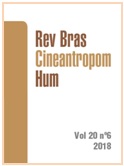Translation, adaptation and validation of the “Measure of older adults sedentary time” questionnaire in Brazilian older adults
DOI:
https://doi.org/10.1590/1980-0037.2018v20n6p491Abstract
Modern lifestyle is associated with prolonged exposure to sedentary behavior (SB), especially in older adults; however, there is a lack of validated questionnaires to measure SB in Brazilian older adults. The aim of this study was to adapt and validate the Brazilian version of the “Measure of Older Adults Sedentary Time” (MOST) questionnaire in Brazilian older adults. Content validity, clarity and concurrent validity of the adapted MOST were examined. Fifty-seven participants (68.7 ± 3.47 years) answered the adapted version of the MOST questionnaire and wore an ActiGraph wGT3X-BT accelerometer for seven days. After this period, participants answered the adapted MOST again and the accelerometer was collected. MOST answers were summed over for calculating self-reported time spent in SB. A cutoff point of < 100 counts/min was applied to accelerometer data for estimating time spent in SB. The relationship between SB estimates from MOST and accelerometer was verified by Pearson correlation, reproducibility was verified by intra-class correlation coefficient (ICC), internal consistency by Cronbach’s alpha (?) and concordance by Bland Altman. Significance was set at P <0.05. Content validity index and clarity index were 100% and 98%, respectively. ICC was 0.72 (95% CI: 0.56-0.82) for total time in SB assessed with the MOST questionnaire. The correlation between SB estimates from MOST and accelerometer data was 0.37 (95% CI: 0.130.58). The adapted MOST systematically underestimated SB compared to accelerometer (measurement bias: -732.8 min/week [2087.6; -3553.2 min/wk]). The adapted MOST questionnaire presents adequate validity for assessing SB in the Brazilian older adults.References
Dunstan DW, Kingwell BA, Larsen R, Healy GN, Cerin E, Hamilton MT, et al. Breaking Up Prolonged Sitting Reduces Postprandial Glucose and Insulin Responses. Diabetes Care 2012;35(5):976–83.
Katzmarzyk PT, Church TS, Craig CL, Bouchard C. Sitting Time and Mortality from All Causes, Cardiovascular Disease, and Cancer: Med Sci Sports Exerc 2009;41(5):998–1005.
Van der Ploeg HP, Chey T, Korda RJ, Banks E, Bauman A. Sitting time and all-cause mortality risk in 222 497 Australian adults. Arch Intern Med 2012;172(6):494–500.
Ainsworth BE, Haskell WL, Whitt MC, Irwin ML, Swartz AM, Strath SJ, et al. Compendium of physical activities: an update of activity codes and MET intensities. Med Sci Sports Exerc 2000;32(9):498–504.
Pate RR, O’Neill JR, Lobelo F. The evolving definition of“ sedentary”. Exerc Sport Sci Rev 2008;36(4):173–8.
Sedentary Behaviour Research Network. Letter to the Editor: Standardized use of the terms “sedentary” and “sedentary behaviours”. Appl Physiol Nutr Metab 2012;37(3):540–2.
Atkin AJ, Gorely T, Clemes SA, Yates T, Edwardson C, Brage S, et al. Methods of Measurement in epidemiology: Sedentary Behaviour. Int J Epidemiol 2012;41(5):1460–71.
Rezende LFM, Rey-López JP, Matsudo VKR, Luiz OC. Sedentary behavior and health outcomes among older adults: a systematic review. BMC Public Health 2014;14(1):333.
Gardiner PA, Clark BK, Healy GN, Eakin EG, Winkler EAH, Owen N. Measuring Older Adults’ Sedentary Time: Reliability, Validity, and Responsiveness. Med Sci Sports Exerc 2011;43(11):2127–33.
Beaton DE, Bombardier C, Guillemin F, Ferraz MB. Guidelines for the process of cross-cultural adaptation of self-report measures. Spine 2000;25(24):3186–91.
Hill MM, Hill A. Investigação por questionário. Lisboa: Sílabo; 2009. p. 377.
Brucki SM, Nitrini R, Caramelli P, Bertolucci PH, Okamoto IH. Sugestões para o uso do mini-exame do estado mental no Brasil. Arq Neuropsiquiatr 2003;61(3B):777–81.
Guralnik JM, Simonsick EM, Ferrucci L, Glynn RJ, Berkman LF, Blazer DG, et al. A Short Physical Performance Battery Assessing Lower Extremity Function: Association With Self-Reported Disability and Prediction of Mortality and Nursing Home Admission. J Gerontol 1994;49(2):85–94.
World Health Organization. Obesity: preventing and managing the global epidemic: report of a WHO consultation. Geneva: World Health Organization. 2000. 253 p. (WHO technical report series).
American College Sports of Medicine. ACSM | News Releases. United States. 2011; Available from: [2017 may 19].
Matthews CE, Chen KY, Freedson PS, Buchowski MS, Beech BM, Pate RR, et al. Amount of Time Spent in Sedentary Behaviors in the United States, 2003-2004. Am J Epidemiol 2008;167(7):875–81.
Troiano RP, McClain JJ, Brychta RJ, Chen KY. Evolution of accelerometer methods for physical activity research. Br J Sports Med 2014;48(13):1019–23.
Gennuso KP, Matthews CE, Colbert LH. Reliability and Validity of 2 SelfReport Measures to Assess Sedentary Behavior in Older Adults. J Phys Act Health 2015;12(5):727–32.
Grimm EK, Swartz AM, Hart T, Miller NE, Strath SJ. Comparison of the IPAQShort Form and accelerometry predictions of physical activity in older adults. J Aging Phys Act 2012;20(1):64–79.
Van Cauwenberg J, Van Holle V, De Bourdeaudhuij I, Owen N, Deforche B. Older adults’ reporting of specific sedentary behaviors: validity and reliability. BMC Public Health 2014;14(1):1.
Gennuso KP, Thraen-Borowski KM, Gangnon RE, Colbert LH. Patterns of sedentary behavior and physical function in older adults. Aging Clin Exp Res 2015;28(5):943–50.
Visser M, Koster A. Development of a questionnaire to assess sedentary time in older persons–a comparative study using accelerometry. BMC Geriatr 2013;13(1):1.
Schuler PB, Richardson MT, Ochoa P, Wang MQ. Accuracy and repeatability of the Yale physical activity survey in assessing physical activity of older adults. Percept Mot Skills 2001;93(1):163–77.
Helmerhorst HJ, Brage S, Warren J, Besson H, Ekelund U. A systematic review of reliability and objective criterion-related validity of physical activity questionnaires. Int J Behav Nutr Phys Act 2012;9(1):103.
Healy GN, Matthews CE, Dunstan DW, Winkler EAH, Owen N. Sedentary time and cardio-metabolic biomarkers in US adults: NHANES 2003-06. Eur Heart J 2011;32(5):590-7.



